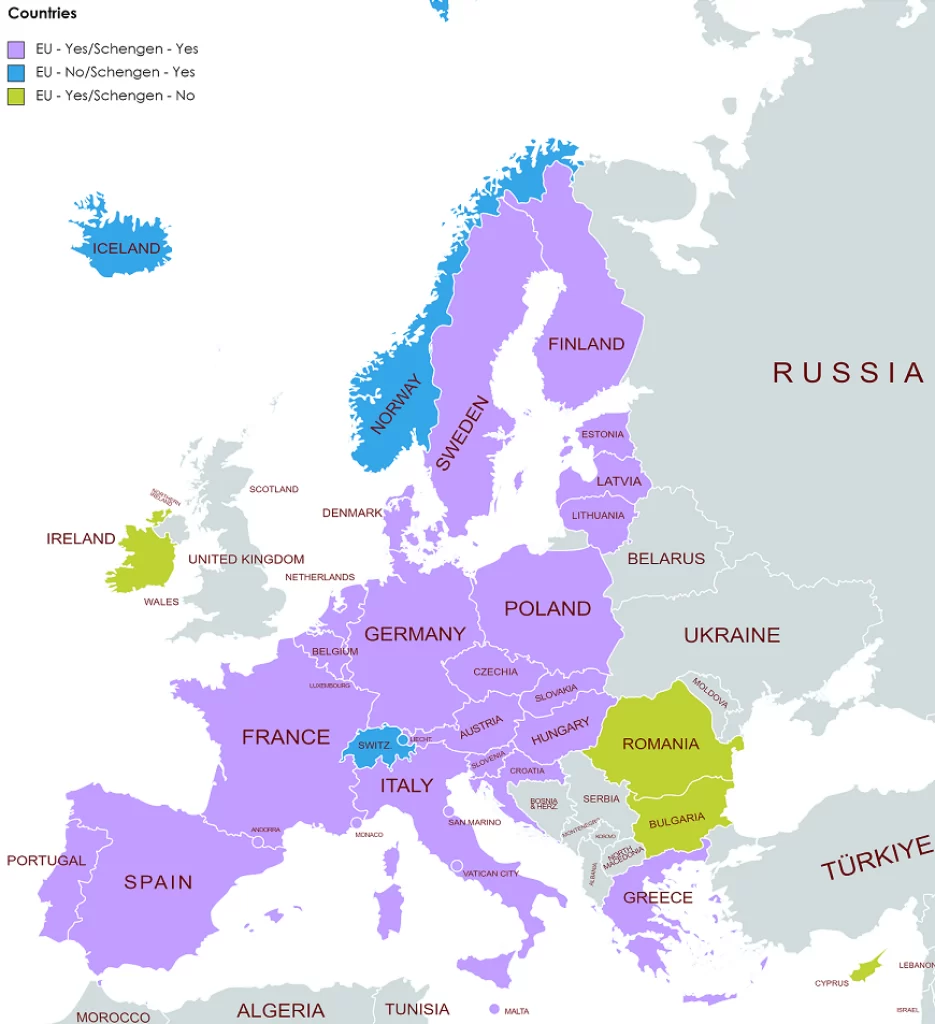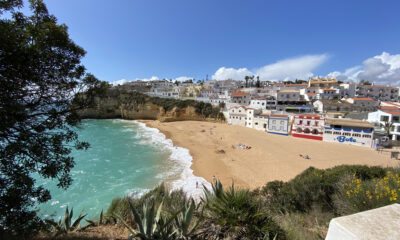Planning to travel around Europe? Confused about what countries are part of the EU, which are in EEA or Schengen, which use Euro, and what’s this ETIAS? Below you can see the list of Member Countries of each of the institutions and a short summary about each of the organizations.
Interesting facts
- The United Kingdom left the EEA when it left the EU on 31 January 2020.
- Iceland, Liechtenstein and Norway are EEA member states, but they are not members of the European Union (EU).
- Switzerland is not a member of the EU or the EEA. However, Swiss nationals have rights which are similar to those of nationals of EEA countries.
- Croatia joined the Eurozone on 1st January 2023 and Bulgaria is hoping to join on the 1st of January 2024.
- Andorra, Monaco, San Marino, and Vatican City have formal agreements with the EU to use the euro as their official currency and issue their own coins. Kosovo and Montenegro have adopted the euro unilaterally, but these countries do not officially form part of the eurozone.
- The Azores, Madeira, and the Canary Islands are special members of the EU and part of the Schengen Zone even though they are located outside the European continent.
- Several European microstates outside of EU have adopted the Euro without being part of EU, namely: Andorra, Monaco, San Marino, Vatican.
- Montenegro and Kosovo are the only two countries that adopted Euro as their own currency without actually being part of Eurozone or signing any Monetary agreement with European Union.
Member Countries
| EU | EEA | EFTA | Schengen | Eurozone € |
|---|---|---|---|---|
| Austria | Austria | Austria | Austria | |
| Belgium | Belgium | Belgium | Belgium | |
| Bulgaria | Bulgaria | Joining 2024 | ||
| Croatia | Croatia | Croatia | Croatia | |
| Cyprus | Cyprus | Cyprus | ||
| Czech Republic | Czech Republic | Czech Republic | ||
| Denmark | Denmark | Denmark | ||
| Estonia | Estonia | Estonia | Estonia | |
| Finland | Finland | Finland | Finland | |
| France | France | France | France | |
| Germany | Germany | Germany | Germany | |
| Greece | Greece | Greece | Greece | |
| Hungary | Hungary | Hungary | ||
| Iceland | Iceland | Iceland | ||
| Ireland | Ireland | Ireland | ||
| Italy | Italy | Italy | Italy | |
| Latvia | Latvia | Latvia | Latvia | |
| Liechtenstein | Liechtenstein | Liechtenstein | ||
| Lithuania | Lithuania | Lithuania | Lithuania | |
| Luxembourg | Luxembourg | Luxembourg | Luxembourg | |
| Malta | Malta | Malta | Malta | |
| The Netherlands | The Netherlands | The Netherlands | The Netherlands | |
| Norway | Norway | Norway | ||
| Poland | Poland | Poland | ||
| Portugal | Portugal | Portugal | Portugal | |
| Romania | Romania | |||
| Slovakia | Slovakia | Slovakia | Slovakia | |
| Slovenia | Slovenia | Slovenia | Slovenia | |
| Spain | Spain | Spain | Spain | |
| Sweden | Sweden | Sweden | ||
| Switzerland | Switzerland | |||
| Andorra (1) | ||||
| Monaco(1) | ||||
| San Marino(1) | ||||
| Vatican(1) | ||||
| Montenegro(2) | ||||
| Kosovo(2) |
Schengen vs EU & non-EU Countries

What are?
European Union (EU)
The European Union (EU) is an economic and political union formed by its member countries, and, within its territory, products, services, people and money can move freely without customs duties or other obstacles. The EU was established with the Maastricht Treaty in 1993.
European Economic Area (EEA)
The European Economic Area was established via the Agreement on the European Economic Area, an international agreement which enables the extension of the European Union’s single market to member states of the European Free Trade Association. The EEA agreement was established in 1994.
European Free Trade Association (EFTA)
The EFTA, or European Free Trade Association, was founded in 1960 to promote free trade between its member countries.
Schengen Area
The Schengen countries form a territory where there are no travel restrictions or border controls between member states. The Schengen cooperation was initiated in 1985 by Germany, Belgium, the Netherlands, Luxembourg and France and it now encompasses almost all EU countries.
ETIAS
There are many countries that are not in the European Union (EU) whose citizens can enter the EU Schengen Zone without needing a visa. Specifically, there are currently 62 countries that are not in the EU but are visa-free. ETIAS stands for European Travel Information and Authorization System. It is a completely electronic system that allows and keeps track of visitors from countries who do not need a visa to enter the Schengen Zone. In a way, it resembles the U.S Electronic System for Travel Authorization (ESTA), which serves a similar purpose.
Eurozone
The eurozone, officially known as the euro area, is a geographic and economic region that consists of all the European Union countries that have fully incorporated the Euro as their national currency. As of Aug. 2020, the eurozone consists of 19 countries in the European Union. Other EU states (except for Denmark) are obliged to join once they meet the criteria to do so.
Last updated November 18, 2023.
REVIEW
FAVOURITES
SHARE
NEWSLETTER
No Spam, Just Updates!
FOLLOW US
DIGITAL NOMAD VISAS












